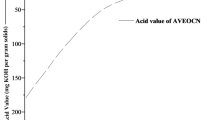Abstract
Acrylated epoxidized soybean and linseed oils of different characteristics were incorporated in the absence and presence of polymeric methylene diphenyl isocyanate (PMDI) in a vinyl ester (VE) resin-based bulk molding compound (BMC) up to 15 wt% (with respect to VE resin). The thermal, thermo-mechanical, static fracture mechanical, dynamic impact (Charpy), and thermal degradation properties of the BMC compounds were determined. With increasing amount of functionalized plant oils the glass transition temperature (T g) of the matrix, the stiffness (E modulus) and Charpy impact strength of the BMCs decreased. The static fracture toughness was slightly increased and the fracture energy remained unaffected by the modification with increasing amount of oil. Additional crosslinking of VE, induced by PMDI, markedly enhanced the T g but yielded a large drop in the glassy modulus. This finding was traced to resin dilution and to unfavored PMDI/kaolin interactions triggered by the water content of the latter. The thermal degradation of the BMCs was less affected, however, their degradation started earlier for the modifications either with functionalized plant oil or PMDI. Dilution of VE-based BMCs with acrylated epoxidized plant oils requires reworking of the corresponding recipes to keep the property degradation limited.













Similar content being viewed by others
References
Auad ML, Proia M, Borrajo J, Aranguren MI (2002) J Mater Sci 37:4117. doi:10.1023/A:1020031701950
Liang G, Zuo R, Lu T, Wang J (2005) J Mater Sci 40:2089. doi:10.1007/s10853-005-1242-2
Karger-Kocsis J, Gryshchuk O, Jost N (2003) J Appl Polym Sci 88:2124. doi:10.1002/app.11946
Karger-Kocsis J, Gryshchuk O, Schmitt S (2003) J Mater Sci 38:413. doi:10.1023/A:1021855228253
Szabó JS, Gryshchuk O, Karger-Kocsis J (2003) J Mater Sci Lett 22:1141. doi:10.1023/A:1025175027424
Rosso P, Fiedler B, Friedrich K, Schulte K (2006) J Mater Sci 41:383. doi:10.1007/s10853-005-2619-y
Karger-Kocsis J, Gryshchuk O (2006) J Appl Polym Sci 100:4012. doi:10.1002/app.23220
Gryshchuk O, Jost N, Karger-Kocsis J (2002) Polymer 43:4763. doi:10.1016/S0032-3861(02)00314-2
Grishchuk S, Karger-Kocsis J (2011) Express Polym Lett 5:2. doi:10.3144/expresspolymlett.2011.2
Fu L, Yang L, Dai C, Zhao C, Ma L (2010) J Appl Polym Sci 117:2220. doi:10.1002/app.32126
Li F, Larock RC (2002) J Appl Polym Sci 84:1533. doi:10.1002/app.10493
Lu J, Khot S, Wool RP (2005) Polymer 46:71. doi:10.1016/j.polymer.2004.10.060
Lu J, Wool RP (2006) J Appl Polym Sci 99:2481. doi:10.1002/app.22843
Grishchuk S, Leanza R, Kirchner P, Karger-Kocsis J (2011) J Reinf Plast Compos 30:1455. doi:10.1177/0731684411421541
Topić M, Katović Z (1994) Polymer 35:5536. doi:10.1016/S0032-3861(05)80020-5
Karger-Kocsis J, Friedrich K (1987) J Mater Sci 22:947. doi:10.1007/BF01103535
Karger-Kocsis J (1989) In: Friedrich K (ed) Application of fracture mechanics to composite materials. Amsterdam, Elsevier, p 189
Acknowledgements
This study was performed in the framework of a bilateral cooperation program between Germany (DAAD) and Hungary (MöB). The authors are thankful to Dr. P. Kirchner (Polynt GmbH, Miehlen, Germany) and to Dr. R. Leanza (Polynt S.p.A., Scanzorosciate (BG), Italy) for providing the BMC compound.
Author information
Authors and Affiliations
Corresponding author
Rights and permissions
About this article
Cite this article
Grishchuk, S., Karger-Kocsis, J. Modification of vinyl ester and vinyl ester–urethane resin-based bulk molding compounds (BMC) with acrylated epoxidized soybean and linseed oils. J Mater Sci 47, 3391–3399 (2012). https://doi.org/10.1007/s10853-011-6186-0
Received:
Accepted:
Published:
Issue Date:
DOI: https://doi.org/10.1007/s10853-011-6186-0




